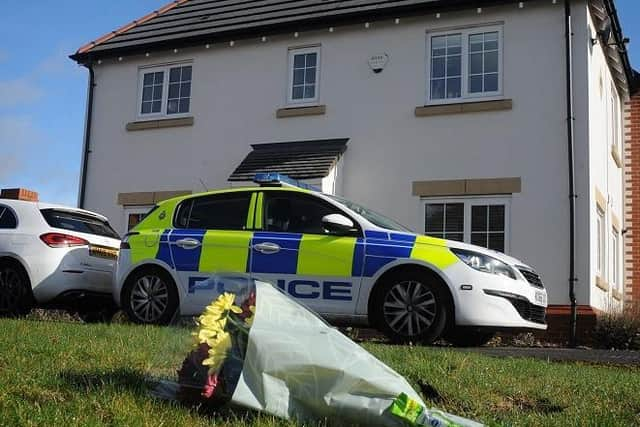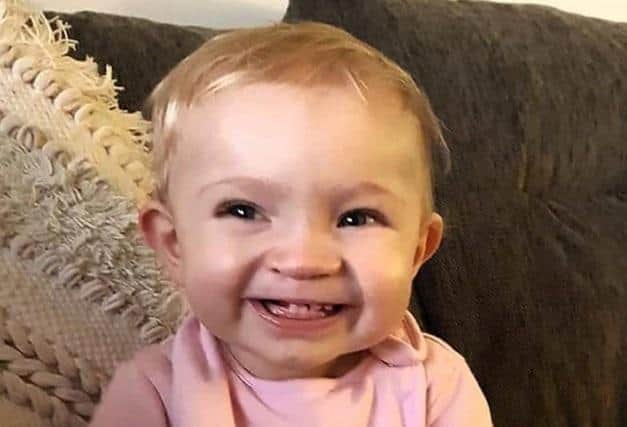Just what did happen to Hollie inside this house?
and live on Freeview channel 276
That was the case put forward by prosecutor Guy Gozem QC at Manchester Crown Court today, as he gave his closing speech in the trial of Daniel Ashurst.
He denies the murder and manslaughter of his 14-month-old daughter Hollie, claiming she was involved in a series of incidents which caused her injuries.
Advertisement
Hide AdAdvertisement
Hide AdMr Gozem said Hollie died on March 1 when her heart stopped, because of the effect on her brain of injuries.


He said: “The question that lies at the heart of this case is, how did she come by those injuries?”
The prosecution’s case is that Hollie’s injuries were “deliberately inflicted” by her father at their home on Fleming Court, Shevington, on February 28.
Mr Gozem said: “What we suggest is a loss of temper and self-control and so an intention of short duration, but an intention nonetheless when we consider those injuries.”
Advertisement
Hide AdAdvertisement
Hide AdHe highlighted evidence from pathologist Dr Charles Wilson, who said Hollie was the “subject of non-accidental injury involving excessive acceleration and deceleration of her head in relation to the rest of her body, with multiple impacts to her head and face.”


She had a fractured ankle, there was “compelling evidence” of bite marks and there was both recent and older bleeding on the brain.
Hollie had a “triad” of injuries - bleeding on the brain and in the eyes and swelling of the brain- which raised concern of inflicted injury, the court heard.
Mr Gozem asked the jury to consider Ashurst’s mood on the day and why he did not tell medics about the series of incidents that he claims caused Hollie’s injuries.
Advertisement
Hide AdAdvertisement
Hide Ad“We say it’s because he only came up with what you heard by way of defence months later, when he realised that the specialists had managed to uncover the extent and the nature of Hollie’s injuries,” said Mr Gozem.
In her closing speech, Nina Grahame QC, defending, highlighted concerns about the triad, including a meeting by the Royal College of Pathologists where there was no agreement on whether it was a reliable indicator or proof of non-accidental injury in young children and babies.
She also cast doubt on research into stairway falls, saying there were no cases that resembled what Ashurst says happened.
Ms Grahame reminded the jury of the judge’s earlier warning to be careful when considering evidence from medical experts.
Advertisement
Hide AdAdvertisement
Hide Ad“Experts are not gods. They don’t know everything. They get things wrong, of course they do, everyone can,” she said.
She pointed out that some bruises on Hollie were caused by medical treatment and that her mother said she had bruises from banging into things, as she was learning to walk.
Ms Grahame said Hollie’s injuries showed she was a child who had fallen, not an abused child who was gripped forcefully and shaken.
She referred to an email from an expert who said it was impossible to rule out that a mark on Hollie was a bite mark, but that it was very large for a bite.
Advertisement
Hide AdAdvertisement
Hide AdMs Grahame spoke of CCTV footage of Ashurst driving from his home to Standish Medical Centre to get help for Hollie. She was in the back of the car and Ashurst’s hands were on the steering wheel.
Further footage when he arrived at the surgery showed him getting out of the car with Hollie in his arms.
The jury earlier heard Hollie fell from the car seat during the journey and he pulled her onto his lap.
Ms Grahame said Ashurst was “not an angel”, taking cocaine and exaggerating for a benefit claim, but that did not mean he was a killer.
Advertisement
Hide AdAdvertisement
Hide AdShe said his use of alcohol and cocaine, as well as his mental health problems, were not new.
“There was no reason at all for this man to have exploded into extreme violence with Hollie on February 28,” she said.
Ms Grahame suggested the evidence would leave the jury “far from sure” that Ashurst killed Hollie.
In his legal directions, Mr Justice Dove said Ashurst faced two charges - murder and manslaughter.
Advertisement
Hide AdAdvertisement
Hide AdMurder means he unlawfully killed Hollie by assaulting her and causing her death, intending to cause her death or really serious injury.
If he intended to cause some harm, short of serious injury, or if by his actions he realised some harm was likely to be caused, he could be found guilty of manslaughter.
Mr Justice Dove summed up the case for the jury, going through the evidence they have heard.
He started with Hollie’s birth on Christmas Eve 2017, operations to repair her cleft lip and palate and checks by health visitors, who said there were no significant health or safeguarding concerns.
Advertisement
Hide AdAdvertisement
Hide AdHe referred to Ashurst’s treatment for depression and anxiety, including an appointment in January last year when he said he thought he may struggle to cope with Hollie when her mother Leanne Thompson returned to work.
On February 27, a woman went to their home to have her nails done by Ms Thompson and her three-year-old son played with Hollie.
The next day, Ashurst drove his partner to work and went to Asda with Hollie, where he had 12 photographs of her taken at Max Spielmann and breakfast in the cafe.
He went home, then went to see a woman about a diet plan. She thought he was not acting how he normally would.
Advertisement
Hide AdAdvertisement
Hide AdAshurst returned home, but at 1.34pm he drove to Standish Medical Centre, carried Hollie in and shouted that he needed a doctor.
A GP described her as “floppy” and efforts were made to resuscitate her, both by staff and then paramedics.
Ashurst told the GP Hollie had fallen down the stairs and cried afterwards, told a paramedic she had fallen down two steps, banged her head and cried, and told another paramedic she had fallen, cried and crawled back up.
Another paramedic noted he gave “a similar but different story” each time.
Advertisement
Hide AdAdvertisement
Hide AdHollie was taken to Wigan Infirmary, where her circulation was re-established seven minutes after arrival. She had been in cardiac arrest for 20 to 30 minutes.
She had a bleed on her brain and she was transferred to Royal Manchester Children’s Hospital.
A body map was made of Hollie’s injuries, some of which were thought to be from medical treatment and others which may have been inflicted, including “fingertip bruising” on her chest.
Doctors concluded Hollie had an unsurvivable injury and she died the next day.
Advertisement
Hide AdAdvertisement
Hide AdThe jury heard evidence of blood stains on items in the family’s home, including a duvet and towel, with the majority of the DNA from Hollie and minority from Ashurst.
Damage to the shorts he wore was also examined.
Cocaine was found in a urine sample from Ashurst, which an expert said he could have taken on February 28.
Examinations after Hollie’s death found multiple injuries, including bleeding to her brain, retinal haemorrhages, brain swelling, bruises, a broken ankle and two possible bite marks.
Dr Wilson spoke about the importance of the “triad plus” which is taking the injuries associated with the triad and considering them alongside other injuries,
Proceeding.